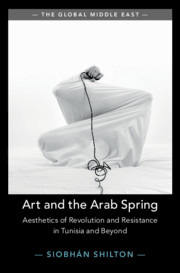Book contents
- Art and the Arab Spring
- The Global Middle East
- Art and the Arab Spring
- Copyright page
- Contents
- Figures
- Acknowledgements
- Introduction
- 1 Aesthetics of Revolution and Infra-thin Critique
- 2 Contingency and Resistance: Exceeding Icons through Matter and Motion
- 3 Contingent Encounters: Artists, Artisans and Amateurs
- 4 Corporeal Resistance and Aesthetics of the Interface
- Conclusion
- References
- Index
3 - Contingent Encounters: Artists, Artisans and Amateurs
Published online by Cambridge University Press: 07 July 2021
- Art and the Arab Spring
- The Global Middle East
- Art and the Arab Spring
- Copyright page
- Contents
- Figures
- Acknowledgements
- Introduction
- 1 Aesthetics of Revolution and Infra-thin Critique
- 2 Contingency and Resistance: Exceeding Icons through Matter and Motion
- 3 Contingent Encounters: Artists, Artisans and Amateurs
- 4 Corporeal Resistance and Aesthetics of the Interface
- Conclusion
- References
- Index
Summary
Chapter 3 develops the idea that contingent encounters are rooted in diversely transnational aesthetics of contingency, but also that this art invents new combinations or strategies specifically to exceed iconic visions. It focuses on work that generates contingency by involving local or regional traditions of weaving and ceramics, as well as artisans themselves. This chapter also addresses art that engages spectators through recent transnational practices, including interactions characteristic of uses of social media. I show that this work diverges from conventional understandings of chance aesthetics and participatory art. I also argue that participatory works exhibited in physical and virtual public spaces, as well as in galleries, blur the boundaries between sites which are conventionally viewed as separate and as associated with either art or activism. I explore contrasting means of evoking encounters between artist and artisans in work on Tunisia by Majd Abdel Hamid (textiles), Selma and Sofiane Ouissi (video performance) and Sonia Kallel (audio tour and video installation) I then address installations by Collectif Wanda, Mouna Jemal Siala and Wadi Mhiri, and Febrik, which involve spectators in ‘reordering space’ or in making alternative ‘icons’ of Tunisia today or of the revolutions in Tunis, Cairo and Damascus.
Keywords
- Type
- Chapter
- Information
- Art and the Arab SpringAesthetics of Revolution and Resistance in Tunisia and Beyond, pp. 117 - 165Publisher: Cambridge University PressPrint publication year: 2021

